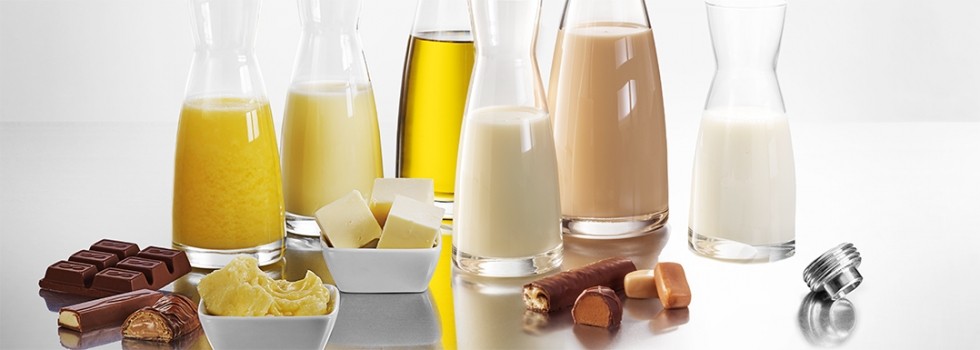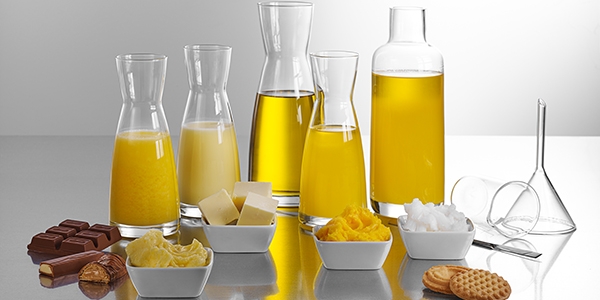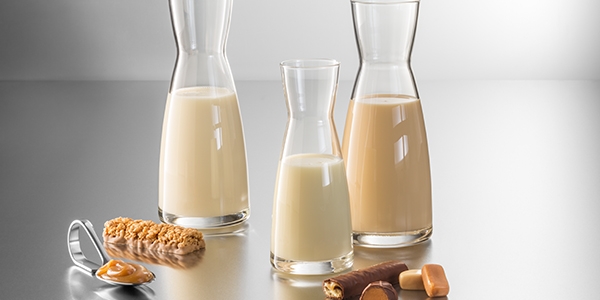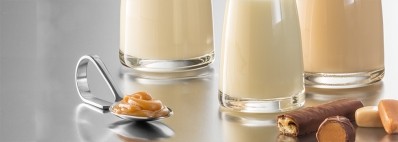Promotional Features
Dairy ingredients and milk fats provide indulgence and taste to chocolates and confectionery
Anhydrous milk fat, butter, sweetened condensed milk or milk powder are important key ingredients for the production of confectionery and chocolate as well as baked goods and biscuits.
They play a decisive role in giving products that great taste and mouthfeel which consumers like.
Milk-based ingredients naturally enhance the taste and mouthfeel especially of chocolate, ice cream and confectioneries, because milk fats will melt in the mouth, leaving a great and pleasant mouthfeel – unlike some (hydrogenated) vegetable fats do.
Dairy ingredients and milk fats are traditional ingredients that have proven their worth for centuries. They serve the trend for clean label ingredients and are nutritionally valuable. Products made with dairy ingredients are associated with very good quality and taste by the consumer, so the slightly higher raw material costs compared to vegetable fat are worth it.
Mr. Bernd Gewecke, Managing Director Sales at Uelzena eG, a German dairy cooperative with a strong focus on the production of milk-based ingredients, says: “Sustainably produced and as naturally clean label products, dairy ingredients are still valuable and value-giving ingredients in today's world.
“In Europe, their production is also controlled by regulations and directives, which ensure a particularly high standard of quality. Dairy ingredients from Germany in particular have a worldwide reputation."
Nowadays a wide variety of different milk fat products are used as ingredients for confectionery. It is worth taking a closer look at the most important of them:
1. Butter and German branded butter
German butter contains a minimum of 82% milk fat and a maximum of 16% water, plus and approximately 2% non-fat milk solids (milk protein, lactose, vitamins and minerals). The melting point is approximately 30°-34°C.1
The production of premium German branded butter is subject to strict regulations and it may only be produced by approved dairies. The product quality is officially monitored on a regular basis. German branded butter is only produced directly from cow's milk or cream obtained directly from it.
The most commonly used type of butter in Germany is acidified butter. For the production of mildly acidified butter, the most commonly used type of butter in Germany, lactic acid bacteria are used in the production process, which ensure a fresh butter taste. Sweet cream butter is also particularly popular for making chocolates and cream fillings. It is produced without the addition of lactic acid bacteria and therefore has a very pure cream taste.
2. Recombined butter and texturized butter
Recombined butter is not churned directly from liquid cream, but is recombined from butterfat (99.8% milk fat) and, if necessary, fractionated butterfat and water with the addition of butter cultures to obtain a 'normal‘ butter. The fat content is normally 82%, alternatively it can be adjusted according to individual requirements.
Furthermore, the special production process ensures optimised product properties such as adjusted predefined melting points and a product quality that is free of fluctuations throughout the year. This is important because the raw material cream has slightly fluctuating properties, influenced for example by seasons and feeding. When producing butter directly from clarified butter by recombination instead of churning normal cream, these fluctuations are avoided.
3. Anhydrous milk fat, butterfat and concentrated butter
Butterfat consists of at least 99.8% milk fat and has a very concentrated buttery taste. Anhydrous milk fat (AMF), also called clarified butter, is classically produced by heating and centrifuging butter, which removes the water contained in the butter as well as a part of the milk protein and milk sugar.
Alternatively, butterfat can also be produced directly from cream. By removing the water and part of the dry matter, butterfat has a longer shelf life than butter. The melting point of butterfat is approx. 30°-34°C. Concentrated butter is naturally free from lactose.
4. Milk fat fractions, oleine and stearine
Fractionated butterfat is obtained by heating and then cooling concentrated butter(AMF) to a certain temperature level. The milk fat fractions with a higher melting point (stearins) crystallise again more quickly during the cooling process and become solid, while those with a lower melting point (oleins) still remain liquid and can easily be skimmed off.
By fractionating, butterfat with certain desired properties is obtained. For example, very specific melting points, which can be significantly higher, but also lower than those of normal butterfat. Fractionated milk fat with a higher melting point is often used for the production of lamination butter sheets, which are required for making puff pastries. The melting point is between 10°-42°C depending on the fraction or the mixture of certain fractions.
5. White butterfat
With a deodorisation plant, the colour, odours and most of the cholesterol can be removed from the milk fat in a purely physical way. The result is a white butterfat that can be used, for example, as a basis for the production of white confectionery as well as white praline fillings and cream masses.
Just as normal anhydrous milk fat, white butterfat has a fat content of 99.8% milk fat and a melting point between 30-34°C. This special product can only be produced by very few dairies in Europe, such as Uelzena eG, because of the particular technology it requires.
6. Cream
Cream has a fat content of at least 10%. The fat content of cream used as an ingredient in confectionery is usually between 30% and 40%.2 Cream is produced by centrifuging milk, which physically separates the milk into milk fat and skimmed milk. It is then usually heat-treated and ripens for a few days in a cream storeroom under controlled conditions. Incidentally, during skimming, a large proportion of the fat-soluble vitamins in the milk are transferred to the cream.
Cream as an ingredient is used pure or as a cream preparation with the addition of sugar or various stabilising systems, for example. For lactose-free variants, the milk is pre-treated enzymatically before centrifugation to break down the lactose contained in the milk. Experienced cream producers like Uelzena eG can adapt the recipes and properties of their cream to the specific application according to the customer's wishes. For example, by using different stabilisers or the targeted control of the crystallisation process during cream ripening.
7. Sweetened condensed milk
Sweetened condensed milk is a popular ingredient for making caramel masses and fillings for chocolate bars and pralines. It is made from fresh pasteurised milk and sugar through purely physical, partial removal of the water by evaporation. Two to three kilogrammes of skimmed or whole milk are needed to produce one kilogramme of sweetened condensed milk.
The targeted control of crystal distribution and grain size during the crystallisation process ensures the desired physical properties, which play a very important role in further processing into confectionery. Sweetened condensed milk is available with different fat and sugar contents. Texture and viscosity can also be specifically adapted for different applications in confectionery production. The usual fat content of sweetened condensed milk varies between 0.3% and just under 10% milk fat.
References
1. Pădureţ, S. (2021). The Effect of Fat Content and Fatty Acids Composition on Color and Textural Properties of Butter. Molecules (Basel, Switzerland), 26(15), 4565.
2. Haisman, D. (2002). Imitation Dairy Products. Encyclopedia of Dairy Sciences. 1380-1383.




